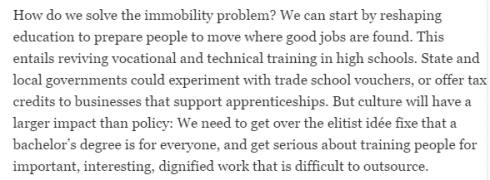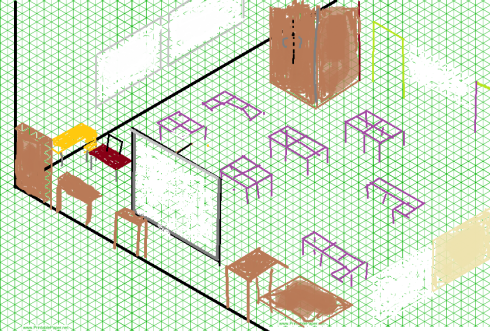(note: I’m calling it vocational ed in the title, but throughout will use career/tech, career ed, whatever.)
In my last post I discussed the reason that skilled career/vocational education training has declined–which is not because schools themselves sneer at anything less than college. For those who keep griping about the “disdain” America shows “the trades”, I hope the last essay provides a better understanding of the tensions involved. Increasing investment in skilled non-college education will require addressing the concerns raised there.
So I thought I’d give it a shot. Here’s what I won’t take on:
- Whether career/tech ed is worth it–This Post story shows that getting a certificate from community college only increases income by $1500/year, which is far better than getting the credential from a for-profit school, which loses people $900/year. Wait, what? For other minds than mine, though.
- Business involvement—certainly, businesses will benefit and thus should fund part of this effort. I’m not sure how, though, and again, turn over to other minds.
- Currency–how do you keep the offerings current? When does it make sense to put resources into training people for a new field? How are winners and losers declared?
All outside my ken. Designing these features hold no interest for me. Because if the system doesn’t address the disparate impact issue I discussed here, then it will ultimately fail either through lawsuit or lack of interest.
A couple years ago, I offered educational solutions, or at least options, for students of middle to low cognitive ability, in Just a Job. The programs I sketch out could easily be included in this program.
I envision “career” or “skills” training, as being designed for cognitive ability levels a bit above and a bit more below average. If using IQs, from 85 to 105.
Right now, we spend millions, at least, on students who are incapable of doing genuine college level work. We loan them money to take courses for which they will get no credit—loans which they will often be incapable of paying back. We spend money on instructors, on space, on curriculum. We deny increased opportunities to qualified students in the form of reduced schedules, thanks to the increased costs of remediation.
Increasing the opportunities for vocational/career training requires setting a standard for college access. We have to stop spending somewhere in order to pay for expanding vocational options. Freeing up the wasted money on wasted college spending is a good place to start. I lay out the case in the attached link.
Increasingly people push to do away with remedial education, which would mean colleges wouldn’t be forcing students to take remedial courses. Marc Tucker, for example, thinks it’s unfair that community colleges require their students to know any advanced math, since the jobs they’ll take on won’t need that math.
But if advanced math isn’t needed for the job, then why is the job requiring college? As I said at the end of the original essay: If no one is too incapable for college, then no education is remedial. So give the students credit for remedial courses, let barely functional students get college degrees after 120 credits of middle school work. No?
(OK, you have to be wondering if I’ve noticed that banning remediation is the Mother Of All Disparate Impact Lawsuits waiting to happen. I did. The rest of the proposal is designed to withstand all but the most illogical objections.)
Limit the scope of community college.
Most states offer three levels of vocational education: high school, community college and regional career centers. The last two are far more extensive than high school programs. Community colleges have appropriated many trade credentials (cosmetology, dental hygiene, auto-mechanics, etc). Low cost, but with often absurd waiting lists, community colleges attach many general education requirements to maintain the illusion of college and an AA degree.
That’s in addition to community college’s original mission: to provide an affordable method of taking general ed courses that will transfer to a four year college or provide stand alone associate degrees. Moreover, community colleges own the bulk of remedial education.
So in this new world, community colleges should be required to dump remedial education, which should be returned to adult education (more on that in a minute). Community colleges should only accept college ready students, as defined in the first step.
I can’t say conclusively that all career training should be removed from community college, which Wikipedia says handles 30% of all CTE. Some career training may have a significant academic requirement that warrant an associate’s degree. But if we are to develop meaningful non-college career training, it can’t be in college, which has a wide range of priorities and is also motivated to devote resources to immigrants.
Increase adult education funding.
Banning college remediation would be incredibly controversial. Many will correctly point out the disparate impact of this ban, that it’s funding higher education for predominantly white and Asian kids. What they wouldn’t mention is that restricting college for the qualified, regardless of race, would improve access and resources for the qualified low income students, again regardless of race.
However, everyone should have the opportunity to become college ready. Not everyone “gets it” the first time, and others finally decide to get serious about the brains they were given. All remediation, K-12 education that simply improves abilities or helps prepare for college, must be shifted to the adult education category, currently funded out of the K-12 budget but now (I hope) would have its own category.
Centralize training programs at the regional level
Someone’s going to ask why not private training programs. Go away and leave me be.
So community colleges should retain their original academic mission for college ready students. Adult education should include both adult remedial education institutions (which would be repurposed community colleges) and the regional career training centers. As I mentioned, many states offer these regional training centers already. These centers offer the best solution to skills education that crosses boundaries from high school to early college—and beyond, for those returning to the trades. All those in the area could attend their local center or apply for a center in another region, much like applying to local vs out of state public colleges today. Students can attend a combination of high school/college and regional trade school as needed.
Critically, students opt in to career training. If the students choose to enter the trades, high schools can’t be held responsible for sending them there. This reduces the potential for racism charges.
Increase resources, reduce selectivity
Today, thanks to the scarcity of career tech vocational programs, at least half the kids accepted are more than smart enough for college and would easily pass a placement test. But if step 1 is implemented, college is going to be much more challenging and college readiness will be a much bigger deal, particularly for those who can achieve it easily.
The “lower half” or more of the kids accepted to these selective programs are generally ambitious, hardworking dedicated kids who know they aren’t academic, but understand they need to have a good GPA. They stay focused. They work hard. They get internships. They get accepted into journeyman positions or move onto the next level of trade schools. They do this with the blessing and support, the letters, the advice, the guidance of their teachers and administration who—please know this—do not sneer at their career choices.
But if these rigorous, selective career and technical programs only accept the kids dedicated and focused enough to avoid all manner of screw-ups, the kids who schlep around, get suspended a few times, flunk math because they think the teacher’s a jerk, have shut themselves out of these options, often before they’re old enough to take advantage of them. Others start out motivated, then lose focus and can never get back on that path.
So “career-technical training”, voc-ed, or whatever you call it, is an excellent option for a lot of low-to-mid cognitive ability kids, but we have to recognize certain realities. These kids will be disproportionately, but not exclusively, black and Hispanic. These kids won’t always be perfectly motivated with spotless resumes.
Keep standards realistic, but challenging. Give kids a reason to work hard to qualify for a program that interests them. Then, be absolutely sure there are seats available for the qualified kids.
Qualify for skilled training using the ASVAB
Elites tend to think anyone not as smart as they are exist in a vast undifferentiated blob. Firefighter, plumber, truck driver, fast food worker–it’s all the same. But in fact, “the trades” encompasses a wide range of cognitive ability levels, and creating a fair means of ensuring rigor in the programs. The military’s ASVAB would be well-suited for this.
And–key plot point–students who need to work and study to qualify for a higher score can use the adult education program to get the support they need.
Build economies around the career centers
Remember, Brooks wants high schools to provide career and technical training so that their students can train and then leave the area. Given the expense of career tech, what states would willingly fund programs to train kids to leave the state?
But if the career centers themselves can rejuvenate–or at least bolster–a weak economy, it might not seem so pointless.
For example, West Virginia could place specialized regional centers in its ten poorest counties, each one focusing on a rigorous technology. Maybe not all–or even some–of the locals can qualify for the technology, but the center itself would provide jobs. The trainers and teachers relocated to the area would spur some growth as well.
Invest in the students
I don’t know if it makes more sense to subsidize career training through low-cost tuition or low-cost loans. Probably some of both. Certainly remedial education should be inexpensive and readily available (although we should not fund living expenses for remedial ed). Essential, though, is the understanding that the investment spigot isn’t shut off for kids who aren’t eligible for college. If, as I suggest, we close off college for many, the money saved must be spent not only on increasing resources for low-income college-ready students, but also on training and investment for students who won’t be going to college.
So there’s the broad outline.
Mentioned briefly here, but the main point of my tweet storm and Just a Job: restricting immigration is essential to invigorating the job and training market for the low skilled. (Note to Brooks: Rick Hess, AEI point man on education, pointedly observed a federal role for education that you might want to write about next time.) Until such time as we finally dramatically restrict immigration, we should at least limit our investment to citizens. Not just the loans, either. (To reiterate, I don’t hate immigrants. But they have no place in our educational system these days. Too expensive.)
We need to advance the debate on skills training, from say age 16 and older. We need to get beyond the tired tripe of “education needs to stop demonizing blue collar work” and start understanding why so few options exist. The only people glorifying college are the progressive and conservative elites. Us proles in the middle are just fine with jobs.
But if we are to start dealing with the difficult challenges that come with a diverse society with wide ranges in cognitive ability, motivation, and needs, then we need to stop the combination of “everyone can succeed” happy talk and “schools SUCK!” condemnation that consumes the discourse today.









